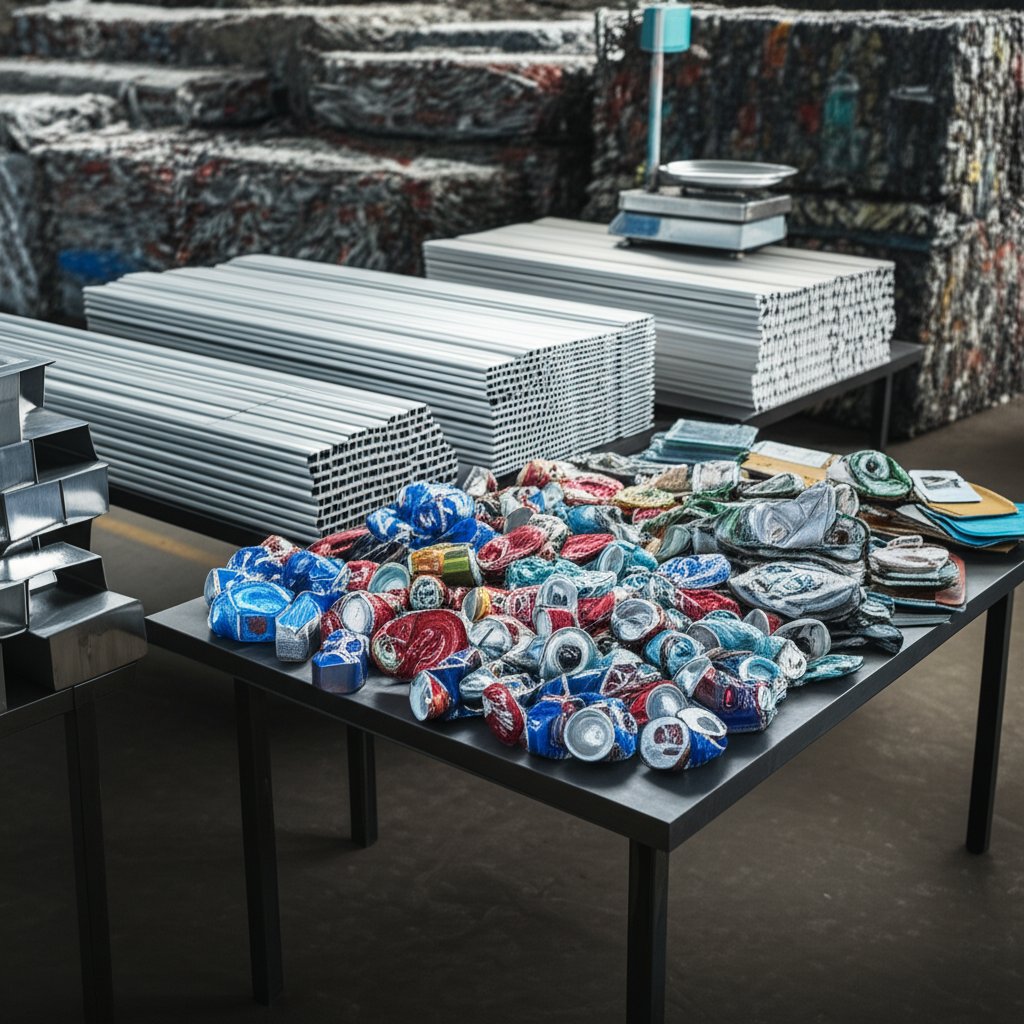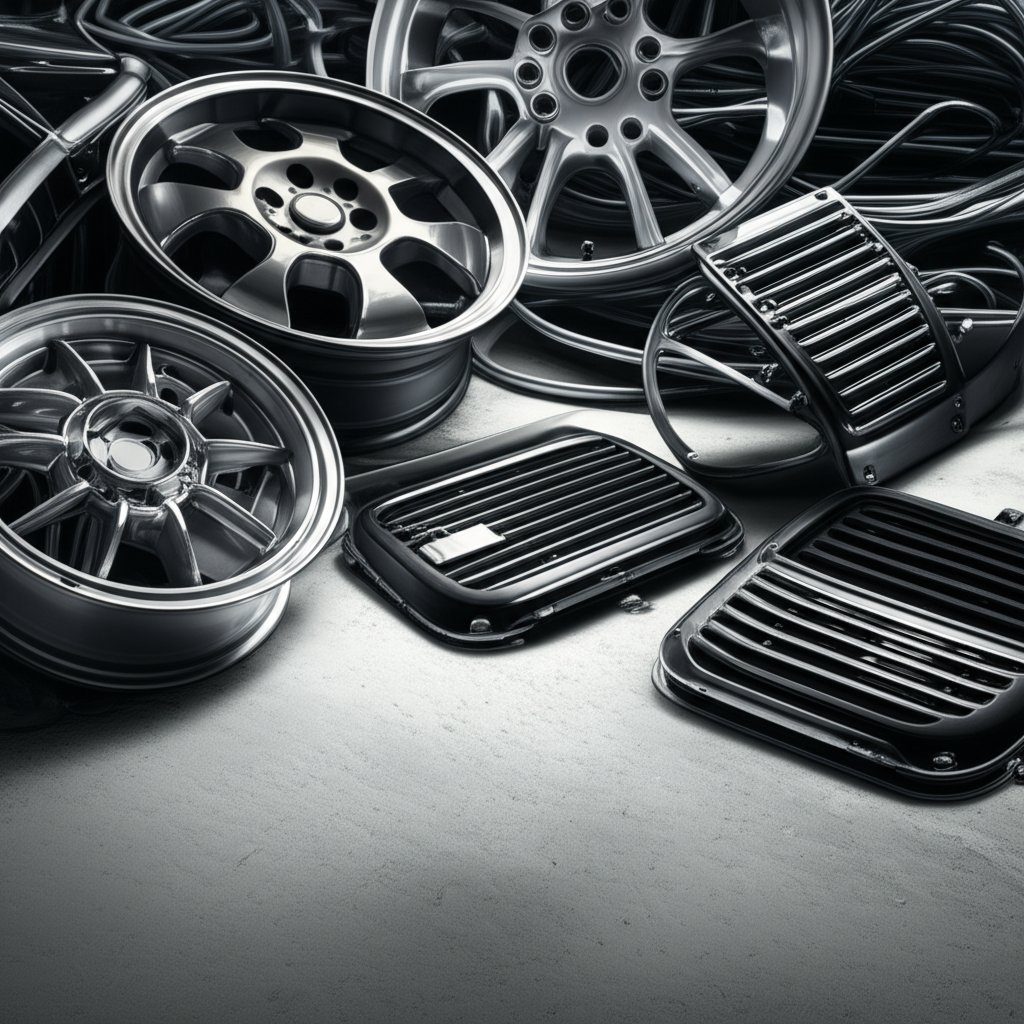
Ever wondered what happens to that empty soda can or the old aluminum siding you replaced last year? The answer is simple: they hold real value, both for your wallet and for the world around you. The aluminum scrap price isn’t just a number—it’s a key factor powering the recycling industry, influencing how much you earn for your scrap and how much energy and resources our society saves.
But why does the value of scrap aluminum matter so much? Let’s break it down with a few practical scenarios:
There’s also a bigger picture. Recycling aluminum isn’t just about earning money—it’s about sustainability. Aluminum is unique among materials because it can be recycled endlessly without losing its quality or properties. In fact, nearly 75% of all aluminum ever produced is still in use today, thanks to effective recycling efforts.
This guide is designed to help you navigate the world of aluminum scrap pricing. Whether you’re a homeowner looking to recycle cans or a business managing industrial scrap, you’ll find practical tips and expert insights to help you unlock the highest possible value from your aluminum scrap—while supporting a greener planet.
When you toss an aluminum can or replace old window frames, do you ever wonder why scrap aluminum is so sought after? The answer lies in aluminum’s unique ability to be recycled endlessly, saving both energy and resources while offering real economic value. Let’s break down exactly why scrap aluminum is such a prized commodity—and how understanding this can help you make the most of aluminum scrap metal prices.
Unlike many materials, aluminum doesn’t lose its quality when recycled. Sounds complex? It’s actually simple science. Aluminum’s atomic structure means it can be melted and reformed without degrading, so every time you recycle it, you’re preserving its core properties. In fact, nearly 75% of all aluminum ever produced is still in use today—a testament to its durability and recyclability.
Here’s where the story gets even better: recycling aluminum uses about 5% of the energy needed to produce new metal from raw ore (Wikipedia: Aluminium recycling). Imagine the energy savings when every can, siding panel, or car part is recycled instead of made from scratch. This massive efficiency translates into:
These benefits make aluminum recycling a win-win for both your wallet and the planet.
Aluminum is everywhere—think beyond just cans. As a non-ferrous metal (meaning it doesn’t contain iron and won’t rust), it’s lightweight, strong, and corrosion-resistant. This makes it a staple in many industries. You’ll notice scrap aluminum coming from:
Sorting and recycling these sources not only supports a circular economy but also ensures the continued supply of high-quality aluminum for new products.
Now that you know why scrap aluminum is so valuable, let’s dig into how it’s priced—starting with the per-pound standards used by scrap yards and recyclers.

When you show up at a scrap yard with a bag of cans or a pile of old window frames, the first thing you’ll hear is the aluminum scrap price per pound. But what does this number really mean—and why does it seem to change every time you check?
Imagine trying to sell scrap aluminum by the piece or by volume. Sounds confusing, right? That’s why scrap yards use the price per pound as the standard. It’s straightforward: the more your aluminum weighs, the more you earn. This method is fair for both sellers and buyers, making transactions transparent and easy to compare across different yards and regions.
When you call or visit a scrap yard, you’ll get a current quote for the price of scrap aluminum per lb. This rate is usually posted daily, reflecting the latest market conditions. But don’t be surprised if the number changes from week to week—or even day to day. Here’s why:
Ever wonder why your neighbor’s clean aluminum siding fetches more per pound than your old lawn chair? It all comes down to grade and form. Scrap yards sort aluminum into categories, each with its own price point:
| Type of Aluminum | Typical Price per Pound | Why the Difference? |
|---|---|---|
| Clean 6063 Aluminum | Highest | Pure, easy to recycle, minimal cleaning needed |
| Aluminum Cans | Moderate | Widely available, but may contain coatings or labels |
| Painted/Dirty Aluminum | Lower | Requires extra processing to remove contaminants |
| Cast Aluminum | Varies | May include other metals or impurities |
Grades matter because cleaner, purer aluminum is less costly to process and can be recycled more efficiently. The less work the scrap yard has to do, the more they’re willing to pay you per pound.
Understanding these factors helps you time your sales and prepare your scrap for the best possible return. Next, we’ll dive deeper into the specific market forces that drive current aluminum scrap prices—so you can plan your recycling efforts with confidence.
Ever checked the current aluminum scrap price and wondered why it keeps changing? If you’ve noticed the ups and downs, you’re not alone. The price you see at your local scrap yard is shaped by a complex web of global and local forces—some you can control, and others you can only watch unfold. Let’s break down these key drivers so you can better predict aluminum scrap prices and make smarter decisions about when and how to sell.
Sounds complex? Here’s a practical look at the main influences, with real-world examples to make things clear:
Imagine you’re holding onto a pile of aluminum scrap. If a new local factory opens and global demand is strong, you might see the current aluminum scrap price spike. But if energy costs soar or a glut of scrap floods your region, prices could soften. That’s why staying informed about both global trends and local happenings is key to timing your sale for the best return.
Understanding these drivers gives you a clearer picture of why aluminum scrap prices move the way they do. Up next, we’ll look at practical tips for getting top dollar for aluminum can scrap—starting with how to prep your cans for the highest payout.
Ever filled a bag with empty beverage cans and wondered, “How can I get the best aluminum can scrap price for this?” You’re not alone. Whether you’re a weekend recycler or collecting cans as part of a larger clean-up, the steps you take before heading to the scrap yard can make a surprising difference in your payout. Let’s break down the practical ways you can maximize your return on aluminum can recycling—without any guesswork.
It might sound simple, but the cleaner your cans, the higher the price you’ll likely receive. Scrap yards prefer aluminum that’s free from food residue, sticky liquids, or dirt. Why? Because contaminants mean more work for the recycler and can lower the value of your load. Before bringing your cans in:
Clean cans are easier to process and command a better aluminum can scrap price at most yards.
Scrap yards pay by weight, but they also pay for purity. Mixing aluminum cans with other materials—like steel cans or plastic bottles—can lead to your entire batch being downgraded, lowering the aluminum can prices scrap yards offer. To avoid this:
Well-sorted loads save time for the recycler and can help you secure a higher per-pound rate.
Should you crush your cans before recycling? Here’s what you need to know:
Check with your local scrap yard about their policy. In general, crushing cans is fine as long as you’re not mixing in other materials or hiding contaminants (Action Metals).
Did you know that bringing in larger quantities of aluminum cans can sometimes earn you a better price per pound? Many scrap yards offer tiered pricing, meaning the more you bring, the higher the aluminum can scrap price you’ll receive. Here’s how to take advantage:
Not only does this approach save on transportation, but it can also boost your bottom line.
"Proper sorting and cleaning of your aluminum cans is one of the simplest ways to maximize your recycling returns."
By following these straightforward steps—keeping cans clean, sorted, and considering volume—you’ll be well on your way to getting the best aluminum can scrap price available. Next, we’ll explore how to apply these principles to other forms of aluminum scrap, so you can unlock even more value from your recycling efforts.

When you think of recycling aluminum, cans might be the first thing that comes to mind. But what about that pile of old bicycle rims, leftover wiring from a renovation, or the cast grill that’s seen better days? These less obvious sources of aluminum scrap can be just as valuable—sometimes even more so—if you know what you’re looking at. So, how do you make sense of the different types, and what should you expect when it comes to their price?
Let’s break it down. Different forms of aluminum scrap are graded and priced based on purity, ease of processing, and the amount of cleaning required. Here’s a handy overview to help you spot the value in your scrap pile:
Here’s a scenario: You bring in a batch of aluminum rims, but you left on the rubber tire and a few lead weights. Instead of earning the full clean aluminum wheel scrap price, you’ll get a lower rate for "dirty" wheels. The same goes for wire with insulation or sheet aluminum with attached nails or plastic. The more effort the scrap yard has to put in, the less they pay you.
Taking the time to prepare and separate your aluminum scrap can mean a noticeable difference in your payout.
Imagine recycling a batch of industrial aluminum profiles that are free from coatings, plastics, or other metals. Not only does this make processing easier, but it also ensures you receive the best possible rate for your material. Sourcing high-quality aluminum—such as the precision-engineered profiles from Shengxin Aluminum—can pay off when it comes time to recycle. These profiles are designed for durability and purity, which translates into higher scrap values at the end of their service life.
As you sort and prepare your aluminum scrap, keep these differences in mind. Up next, we’ll explore how to track down the best local prices for your scrap—so you can turn your knowledge into real returns.
Ever wondered, “Where can I get the best scrap aluminum prices near me?” If you’re ready to cash in your cans, wheels, or other aluminum items, knowing how to quickly and accurately find local rates is key to maximizing your return. The good news? You don’t need to be a scrap metal insider to get the information you need—just a few practical steps can help you compare offers and pick the best deal.
Imagine you’ve gathered a pile of aluminum scrap and want to know what it’s worth. Your first move? Go online. Many scrap yards post their current aluminum prices on their websites or through national directories. Here’s how to get started:
Online prices are a great starting point, but actual payouts can change quickly due to market shifts or yard-specific policies. To avoid surprises, pick up the phone and call a few local yards directly. Ask:
Jot down the answers and compare them. Some yards may offer better rates for clean or sorted scrap, while others might have minimum weight requirements for top-tier prices.
Want to keep tabs on price trends or get alerts when rates spike? Download a specialized app like the iScrap App. With features such as real-time price updates, notifications, and a directory of local yards, you can:
These tools are especially helpful if you regularly recycle or want to time your sale for maximum profit (iScrap App).
Here’s where your research pays off. After gathering prices from websites, apps, and phone calls, line up your options. Consider not just the price per pound, but also:
Sometimes, a slightly lower price at a nearby yard can still net you more after accounting for gas or time. Don’t be afraid to mention competing offers—some yards may match or beat a competitor’s rate to earn your business.
"Using online tools and calling local yards puts the power in your hands to secure the best aluminum scrap prices near you."
By following these straightforward steps—searching online, making a few calls, leveraging apps, and comparing offers—you’ll turn your scrap aluminum into the best possible payout. Next, we’ll dive into the specific factors that influence aluminum scrap rates at the yard, so you know exactly what drives those numbers up or down.
Ever wondered why the current aluminum scrap price at your local yard isn’t always what you expect, even if you’re bringing in the same type of material? The answer lies in the many variables that go into setting scrap aluminum prices. Understanding these elements can help you prepare your scrap for the best possible payout and avoid surprises at the scale.
Let’s break it down. When you arrive at the scrap yard, your aluminum is evaluated on several key criteria. Each factor can raise or lower the price you receive per pound. Here’s a closer look at what matters most:
| Factor | How It Affects Price | Practical Example |
|---|---|---|
| Purity/Cleanliness | Clean, pure aluminum is worth more. Dirt, oil, paint, or attached materials lower the price. | Rinsed, label-free cans fetch more than dirty, food-stained ones. Clean wheels (no tires) are more valuable than those with rubber or weights attached. |
| Quantity/Volume | Larger loads may qualify for better rates or bonuses. | Bringing in 100 lbs of clean extruded aluminum may earn you a higher per-pound price than a 10-lb batch, thanks to volume pricing. |
| Alloy Type/Grade | Certain alloys (like 6063) are more desirable and command higher prices than common grades (like 6061). | Clean 6063 extrusions are often at the top of the price list, while mixed or unknown alloys are downgraded. |
| Preparation/Sorting | Pre-sorted, separated aluminum saves the yard time and boosts your payout. | Sorting cans, wheels, and extrusions into separate bins can mean the difference between top dollar and a blended, lower price. |
| Contaminants | Non-aluminum attachments (steel, plastic, insulation) reduce value, sometimes by half. | Aluminum wire with insulation is worth less than bare wire; wheels with bolts or wheel weights attached are downgraded. |
| Market Fluctuations | Global supply/demand, energy prices, and commodity markets shift rates daily or weekly. | Prices may spike after a surge in global demand or drop if there’s a glut of scrap in your region. |
"The better condition and preparation of your aluminum scrap, the higher the price you’ll receive—often making the difference between an average and a top-tier payout."
Now that you know exactly what influences scrap aluminum prices, you can take practical steps to boost your return. Up next, we’ll share actionable strategies for maximizing your aluminum scrap payout—so you leave the yard with the best deal possible.

Ever wondered why two people can bring similar loads to the scrap yard but walk away with very different payouts? The answer is in the details. Getting the best price of scrap aluminum isn’t just about timing—it’s about preparation, strategy, and knowing how the system works. Let’s break down the most effective ways to make every pound of aluminum count, whether you’re cashing in cans or recycling industrial profiles.
Imagine you show up at the yard with a mixed bag—old window frames, some wiring, a pile of cans, and a few cast grill parts. If you hand it over unsorted, you’ll likely get the lowest blended rate. But if you separate each type, you’ll unlock higher per-pound prices for the premium grades. Here’s how to do it:
Aluminum with steel bolts, plastic, rubber, or insulation attached is considered “dirty” and often fetches only half the price of clean scrap. Before you load up:
The cleaner your material, the higher the price per pound for aluminum scrap you’ll receive (iScrap App).
Did you know many scrap yards offer higher rates for larger loads? If you can, store up your aluminum until you have enough for a bulk sale. This is especially true for businesses or contractors with regular scrap output. Here’s why:
Consider teaming up with neighbors, coworkers, or local groups to combine scrap for a bigger payout.
Ever felt unsure if you’re being paid fairly? Knowing how your scrap is weighed and priced puts you in control:
This transparency ensures you get the full value for each grade of aluminum you bring in.
Regular sellers—especially businesses—can often negotiate better rates by building trust with local yards. Here’s how:
Some yards may even offer container drop-off and pick-up services for large clients, saving you time and effort.
For businesses using industrial aluminum profiles—such as manufacturers or fabricators—the quality of your material can significantly impact end-of-life scrap value. Imagine recycling a batch of precision-engineered, contamination-free profiles: you’ll command a higher price than mixed, lower-grade material. That’s why sourcing from reputable suppliers like Shengxin Aluminum not only ensures performance during use but also maximizes returns when it’s time to recycle. Their high-purity, well-documented alloys are prized by scrap yards, making your recycling process smoother and more profitable.
"Taking the time to sort, clean, and prepare your aluminum scrap is the single most effective way to boost your payout—turning what might seem like small steps into real cash at the scale."
By following these strategies, you’ll consistently secure the best price of scrap aluminum—whether you’re a weekend recycler or a large-scale business. Next, we’ll wrap up with a summary of the key takeaways and encourage you to put your new knowledge into practice for maximum returns and sustainability.

Ever wondered if your efforts to sort, clean, and recycle aluminum truly pay off? As you’ve seen throughout this guide, understanding the aluminum scrap price isn’t just about chasing numbers—it’s about making smart, sustainable choices that benefit your wallet and the world around you.
"Every can, wheel, or profile you recycle is a step toward a cleaner planet and a healthier bottom line."
Ready to put your knowledge into action? Start by sorting and cleaning your aluminum scrap, checking local prices, and timing your sale for the best return. For businesses and manufacturers, sourcing high-quality, pure aluminum profiles—like those from Shengxin Aluminum—ensures you’ll unlock maximum value when it’s time to recycle, thanks to their reputation for purity and performance.
Recycling isn’t just about today’s aluminum scrap price—it’s about building a sustainable future, one load at a time. So gather your scrap, make the most of every pound, and join the movement toward smarter, greener recycling. Your efforts matter—both for your community and for generations to come.
Aluminum scrap prices are affected by global demand, local supply, commodity market trends, the type and cleanliness of the scrap, and the volume you bring in. Clean, sorted, and high-grade aluminum fetches the best rates, while contaminated or mixed materials are valued lower.
To maximize your return, rinse and dry your cans, sort them from other materials, and accumulate a larger quantity before selling. Many scrap yards offer better rates for clean, bulk loads. Always check with local yards about their policies on crushing cans and minimum quantities.
Different forms of aluminum—like wheels, wire, extrusions, or cast items—vary in purity and ease of recycling. Clean, single-alloy items are more valuable because they require less processing. Contaminated or mixed-material scrap needs extra work, which lowers its price.
Search scrap yard directories, use price-tracking apps, and check local yard websites for updates. Calling multiple yards for real-time rates and comparing offers ensures you get the best local price for your scrap aluminum.
Yes, sourcing high-quality, pure aluminum profiles—such as those from Shengxin Aluminum—means higher end-of-life scrap values. Clean, well-documented alloys are easier to recycle and command premium prices from scrap yards.
 Інтернет-сервіс
Інтернет-сервіс 0086 136 3563 2360
0086 136 3563 2360 sales@sxalu.com
sales@sxalu.com +86 136 3563 2360
+86 136 3563 2360